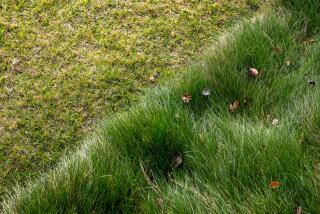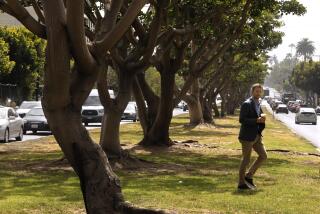Rethinking the Lawn
A lawn gulps down more water that anything else around the home. It is the most artificial element of the garden in an arid climate such as ours; in a true xeriscape, there would be no lawn as we know it. In many gardens a lawn’s value is questionable, though, frankly, there are few things as easy to tend even if care must be fairly constant.
The eye clearly needs re-educating. Paving--something attractive, not just concrete--provides, with paths and vistas, the feeling of openness that a lawn brings to a garden. Though the English made lawns the essential element they are today (quite easily done there; the grass just grows), several of their most famous gardens have no lawns at all but use great expanses of paving or low-growing plants.
Replacing a lawn with ground covers is not the cure-all it was once thought to be. While ground covers call for less regular maintenance, when they do require work, it tends to be backbreaking. Anyone who has had to cope with a ground cover filled with weeds knows this.
Gardeners who can’t imagine life without a lawn, or those with a recreational need (they have kids), might consider a smaller one. Instead of replacing the lawn with paving, treat it as though it were paving, using it functionally and sparingly.
Another option is to change the type of lawn you grow. The new turf-type tall fescues (such as ‘Marathon’ and ‘Medallion’) and most of the warm-season grasses, including common Bermuda, need much less water than bluegrass or rye. In about two years, look for a new zoysia grass named ‘El Toro,’ selected by the University of California for its drought tolerance and other low-maintenance characteristics.
At the very least, lawns should be watered accurately. Take a weekend to fix the sprinklers so they irrigate only the lawn; a lot less water will run down the gutters. The amount of water to give a lawn has always been hard to ascertain because of the many variables. But the Los Angeles Department of Water has given it a shot. Customers may write for its nifty, sliding chart that lets you calculate how much water to use. The Metropolitan Water District of Southern California has a similar guide.
In a nutshell, the DWP suggests that you measure how much water your sprinklers are applying. Set a coffee can in the center of the lawn, let the sprinklers run for 15 minutes, and then measure the depth of the water in the can. Then use this guide. The amount of water in the can:
” 3/8” 1/2” 3/4”
How many minutes to water every third day:
Spring 20 14 10 7 Summer 22 16 12 8 Fall 15 10 8 5
There are other factors, such as how hot or cloudy it is, what kind of soil you have or how far inland you live (these are discussed in the Metropolitan guide), but this chart gives you a start.






